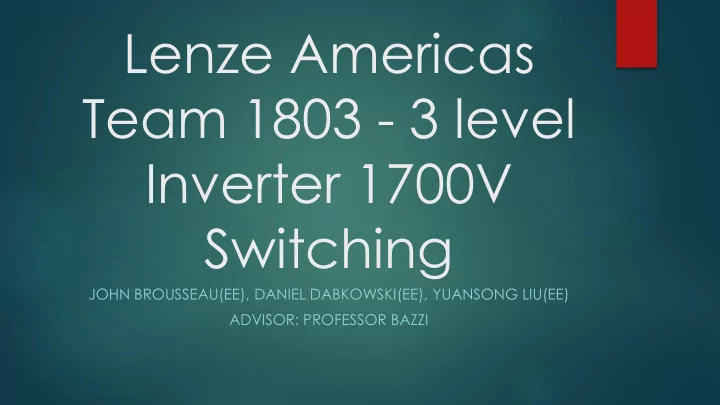

Lenze Americas Team 1803 - 3 level Inverter 1700V Switching JOHN BROUSSEAU(EE), DANIEL DABKOWSKI(EE), YUANSONG LIU(EE) ADVISOR: PROFESSOR BAZZI
Outline Background on Inverters Problem Statement Specifications and Require Approach Capacitive Coupling Logic Based Approach Mixed Approach Simulation Results Hardware Results Upcoming Plans Timeline
Inverters A power inverter is an electronic device that performs DC to AC conversion A three-phase, two-level inverter varies the line to line output voltage between Vdc, -Vdc, and 0 A three-phase, three-level inverter can vary the output between Vdc, Vdc/2, 0, -Vdc/2, and -Vdc
Two level inverter output Three level inverter output
Problem Statement Some parts of Canada and the United States use 600 Vrms systems Inverters designed for this market normally used 1400 V transistors These Transistors are being phased out Nearest equivalents are 1200 V and 1700 V transistors 1700 V transistors do not switch fast enough for the application 1200 V transistors will fail due to high voltage stress
Lenze wants to use a 3 level inverter topology to do two level switching Transistors would be paired, and switched together as a two level inverter The transistors share the load These transistors do not have the same turn on and turn off characteristics They may still experience overvoltage conditions
Specifications and Requirements $2000 budget for this project, main cost will be power MOSFETs ~$5 each, and PCB Simulation of 600 VRMS (850VDC) 3 HP three level inverter: characterize losses, select components, find output waveform, and demonstrate voltage sharing Scaled down simulation to 240 VRMS (340 VDC) 3 HP Physical PCB, 240 VRMS input, 3 HP, interface with a provided Lenze Variable Frequency Drive
Simultaneous Switching Ideal case involves two series MOSFETs switching simultaneously and evenly balancing the DC voltage, with both having on On-State VDS of VDC/2 In practice, this is a concern because each transistor will have slightly different characteristics, such as internal capacitances This will cause the transistors to have different turn-on and turn-off times, which can cause excessive voltage stress across an individual transistor
Approach Capacitive Coupling Utilizes one gate drive signal to power a stack of series MOSFETs, two in our case When all transistors are off, the external resistors divide the voltage load to not exceed the voltage rating of any one transistor Bottom transistor is switched on, which reverse biases the diode, causing the gate-source voltage of M2 to be set by a capacitive division of C2 and internal gate-source capacitance of M2, which turns on M2, process repeats for each transistor in the stack Turn-off is opposite, C2 and internal gate-source capacitance of M2 drain and turn off the transistor, which then happens for every other transistor in the stack Benefit of simplicity and few parts
Approach Logic Based Solution Use solid state components to introduce additional switching logic A = (NOT C) AND S1 B = (NOT D) AND ((NOT C) OR S1) Sequence the transistors such that they do not C = (NOT A) AND ((NOT B) OR S2) go into overvoltage states D = (NOT B) AND s2 A combination of logic statements (Top) will switch the transistors through a series of states (bottom) where there is never more than two on at one time Benefits: No risk of overvoltage, always know which transistors will turn on or off next Drawbacks: Slower that switching simultaneously, several additional parts
Approach Mixed Solution Mixed Approach uses a control signal to determine if the inverter gates should be run in logic-control mode, or through capacitively coupled method Hybrid of the two previous methods Benefit of flexibility Drawback of complexity, current problem involving slew rates
Logic Power Controls MOSFETs
Simulation Results Capacitive Coupling Good Voltage balancing across both transistors Minor turn-on transients
Monte Carlo Analysis Both are equal Top +20% Top -20% Bottom -20% Bottom +20% Max Vds Top 248 243 245 Max Vds bottom 226 226 226
Simulation Results Logic Based Solution Using Simulink, we tested what happened when one transistor consistently switched slower than the other three on a phase leg Normally, each transistor operated at either VDC/2 or 0 V During each cycle, one transistor spiked to VDC, as expected
Simulation Results: Logic Continued Once the additional switching logic was added, the transistors switched on and off in the desired sequence (Top) Additionally, the sequenced switching had the desired effect of eliminating voltage spikes (Bottom)
Hardware Results Capacitive Coupling Method
Upcoming Plans Finish hardware testing for capacitive coupling and logic based method Finish simulation of mixed approach to determine feasibility Purchase parts for three-phase, three-level inverter topology
Timeline
Questions
Recommend
More recommend